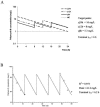Pharmacodynamics of polymyxin B against Pseudomonas aeruginosa
- PMID: 16127031
- PMCID: PMC1195418
- DOI: 10.1128/AAC.49.9.3624-3630.2005
Pharmacodynamics of polymyxin B against Pseudomonas aeruginosa
Abstract
Despite limited data, polymyxin B (PB) is increasingly used clinically as the last therapeutic option for multidrug-resistant (MDR) gram-negative bacterial infections. We examined the in vitro pharmacodynamics of PB against four strains of Pseudomonas aeruginosa. Clonal relatedness of the strains was assessed by random amplification of polymorphic DNA. Time-kill studies over 24 h were performed with approximately 10(5) and 10(7) CFU/ml of bacteria, using PB at 0, 0.25, 0.5, 1, 2, 4, 8, and 16x MIC. Dose fractionation studies were performed using an in vitro hollow-fiber infection model (HFIM) against a wild-type and a MDR strain. Approximately 10(5) CFU/ml of bacteria were exposed to placebo and three regimens (every 8 h [q8 h], q12 h, and q24h) simulating the steady-state unbound PB pharmacokinetics resulting from a daily dose of 2.5 mg/kg of body weight and 20 mg/kg (8 times the clinical dose). Samples were obtained over 4 days to quantify PB concentrations, total bacterial population, and subpopulation with reduced PB susceptibility (>3x MIC). The bactericidal activity of PB was concentration dependent, but killing was significantly reduced with a high inoculum. In HFIM studies, a significant reduction in bacterial load was seen at 4 h in all active regimens, but selective amplification of the resistant subpopulation(s) was apparent at 24 h with the clinical dose (both strains). Regrowth was eventually observed in all dosing regimens with the MDR strain, but its occurrence was prevented in the wild-type strain by using 8 times the clinical dose (regardless of dosing intervals). Our results suggested that the bactericidal activity of PB was concentration dependent and appeared to be related to the ratio of the area under the concentration-time curve to the MIC.
Figures






References
-
- D'Argenio, D. Z., and A. Schumitzky. 1997. ADAPT II user's guide: pharmacokinetic/pharmacodynamic systems analysis software. Biomedical simulations resource, University of Southern California, Los Angeles.
-
- Drusano, G. L. 2004. Antimicrobial pharmacodynamics: critical interactions of ‘bug and drug’. Nat. Rev. Microbiol. 2:289-300. - PubMed
-
- Evans, M. E., D. J. Feola, and R. P. Rapp. 1999. Polymyxin B sulfate and colistin: old antibiotics for emerging multiresistant gram-negative bacteria. Ann. Pharmacother. 33:960-967. - PubMed
MeSH terms
Substances
LinkOut - more resources
Full Text Sources
Other Literature Sources
Medical

